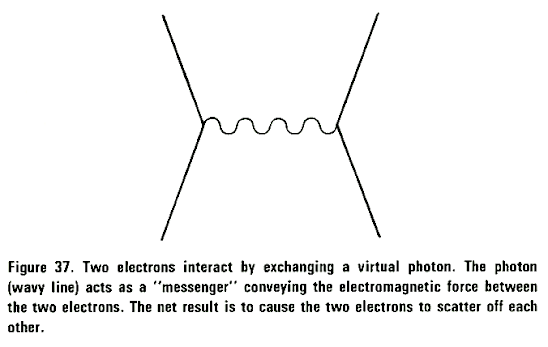Davies & Gribbin (1992: 230-1):
A charged particle, such as an electron, which is the source of an electromagnetic field, can be envisaged as a point of matter at the centre of a field of unseen electromagnetic energy, surrounding it like a halo extending into space. When another electron approaches close to the first electron, it senses the field and experiences a repulsive force. It is as though the field of one electron sends out a message: "I'm here, so move." The message travels through the field in the form of a disturbance, which exerts a mechanical effect both on the receiving particle (action) and on the transmitting particle (reaction). In this way, electrically charged particles act on one another across empty space.
And, of course, in the classical picture of this process at work the messages linking all charged particles in a network of action and reaction are carried by ripples in the electromagnetic field, that is, by electromagnetic waves.
Quantum theory retains the basic idea of a field, but the details are radically altered. Electromagnetic disturbances, as we have seen, can be emitted or absorbed only in discrete packets, or quanta, known as photons, so we must envisage the disturbance in the electromagnetic field which conveys the interaction as involving the exchange of photons. These photons, in effect, carry the messages between electrons and other charged particles. Instead of envisaging the field of one electron continuously disturbing the path of another, we must picture instead the first electron emitting a photon which is then absorbed by the other (Figure 37).
It is rather like firing cannonballs across space; the first electron recoils in response, while the second is deflected by the impact. The disturbance therefore takes place abruptly. An observer would see the end result as the scattering of one electron away from the other, and infer that their electric charges were causing a repulsion.
Blogger Comments:
To be clear, by this description, the electromagnetic force between electrons is said to be conveyed by a disturbance propagating through an electromagnetic field. In classical physics, this disturbance is interpreted as an electromagnetic wave, whereas in quantum physics, it is interpreted as an emitted and absorbed virtual photon.
From the perspective of Systemic Functional Linguistic Theory, a particle is an instance of a probability wave, and so the wave in the Feynman diagram (Figure 37) actually represents the potential of a virtual photon.

No comments:
Post a Comment